The Moto E (2015) Review
by Brandon Chester on April 21, 2015 8:00 AM EST- Posted in
- Smartphones
- Motorola
- Mobile
- Moto E (2015)
CPU Performance
The 2015 Moto E with LTE is the first device with Snapdragon 410 that we've run through our tests. However, buyers of the 3G versions will only get a quad core Snapdragon 200 with 4 Cortex A7 cores. While this is still an improvement over the original, it's quite a disappointment when compared to the LTE edition. To be clear, the results below are from the Snapdragon 410 version, not the Snapdragon 200 version.
Qualcomm's MSM8916 is a quad core Cortex A53 part. Motorola's implementation has it running with a peak CPU core frequency of 1.2GHz, and it's paired with a 400MHz Adreno 306 GPU. Like the Cortex A7 cores used in Snapdragon 410, Cortex A53 is still a dual-issue in-order design, and pipeline depth remains the same as well. ARM has greatly improved branch prediction accuracy and expanded how instructions can be co-issued with Cortex A53, and so much of the performance increase over Cortex A7 will come from those improvements.

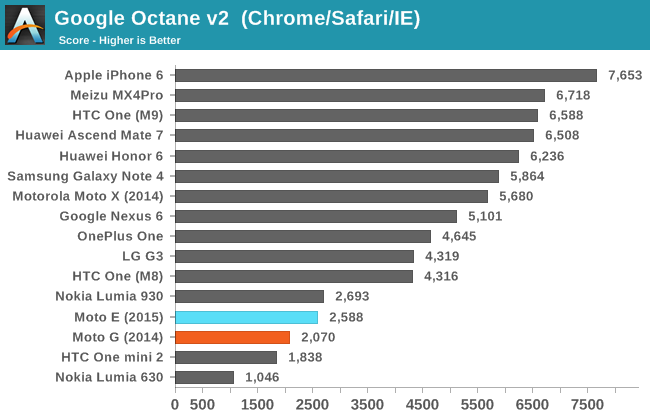
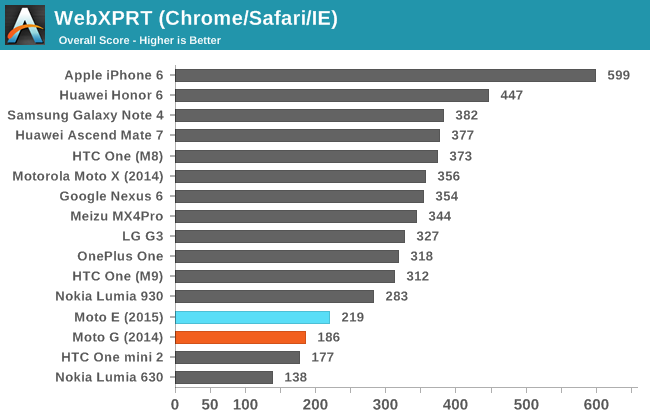
The Moto E shows a decent improvement over Snapdragon 400 based devices like the Moto G, and the improvement over the original Moto E would be even larger. That being said the Moto E doesn't do quite as well as one might expect in our browser tests. Browser optimizations play no small part in this, with Chrome having lagged behind the stock browser from other manufacturers for some time now. Motorola's devices use Chrome as their default browser, and I have a feeling that to an extent the Moto E is limited by software here rather than hardware.
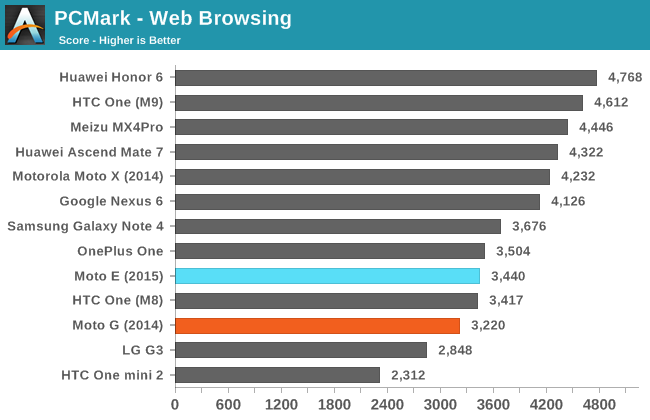

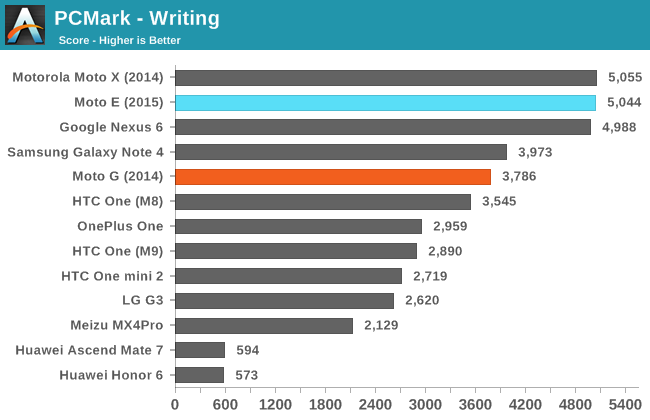
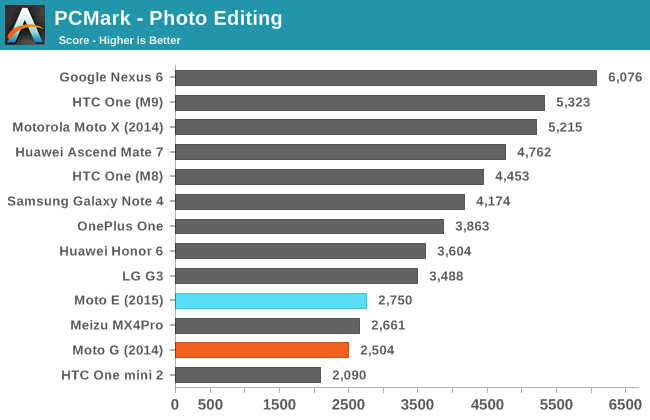
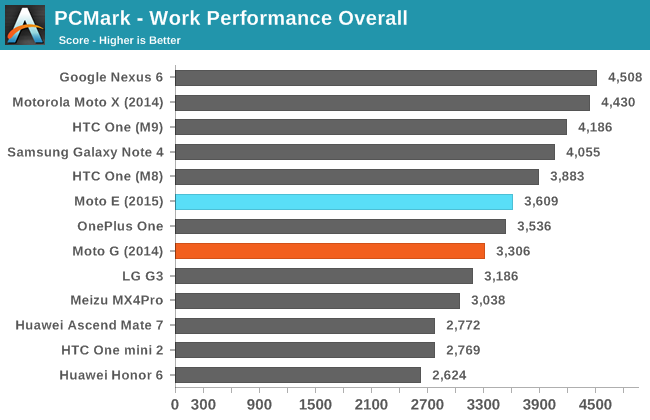
PCMark is a benchmark that focuses more on real-world scenarios where race to sleep speed is paramount. In it we see another modest overall lead compared the Moto G. The writing test in particular shows a great deal of improvement, while the video playback test is slightly worse which I suspect is the result of the Moto E's flash storage speeds causing video seek times to be longer than the Moto G.
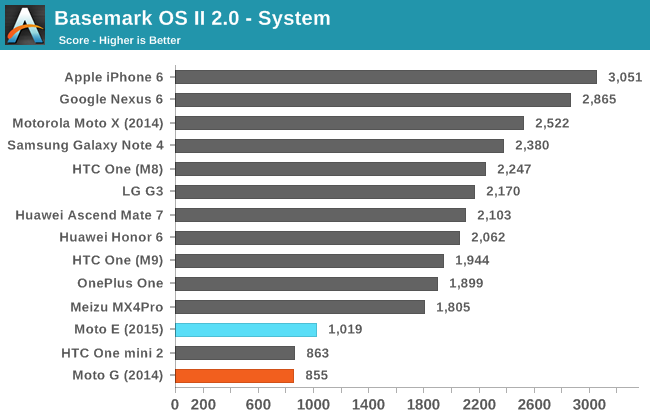
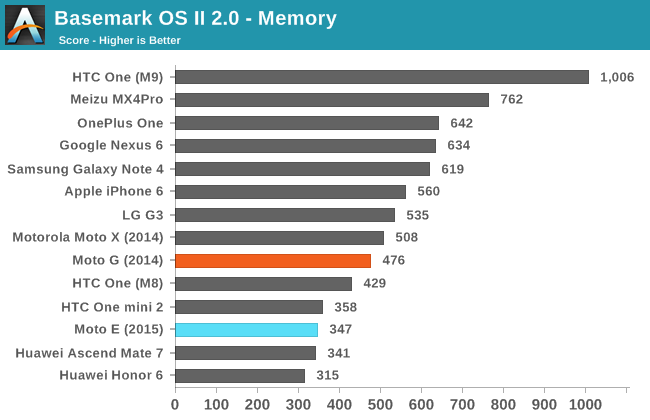
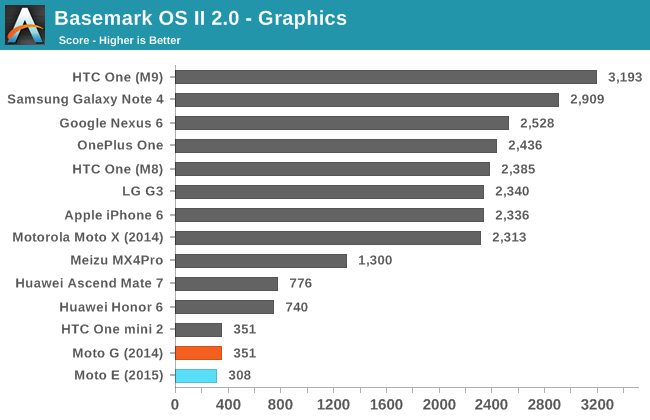
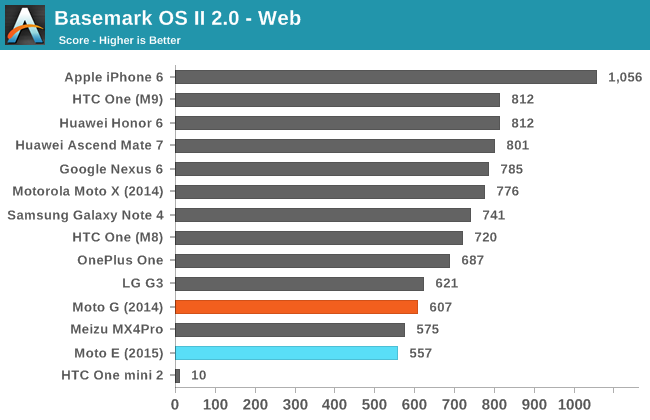
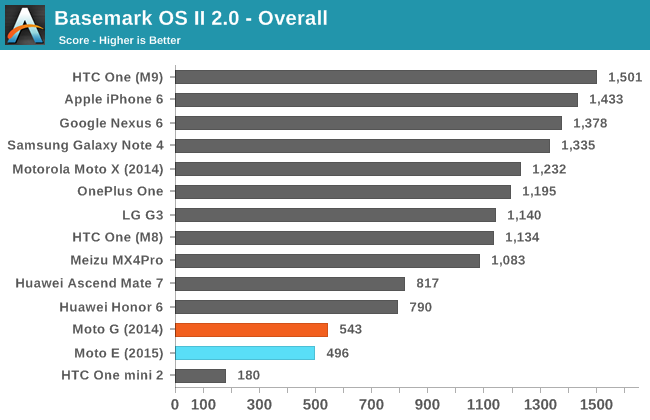
In BaseMark OS II we actually see the Moto E performing worse than the Snapdragon 400 powered Moto G. The Moto G's higher score in the memory subtest helps to give it an advantage overall, and I'm at a loss to explain why the Moto E scores 50 points lower than the Moto G in the Web subtest. I can only imagine that the cause is related to software tuning but I can't definitively say why the gap is as large as it is.
Overall the Moto E does perform well for a budget device, but I do wish Snapdragon 410 showed a greater performance uplift over Snapdragon 400. With only 1GB of RAM and a maximum memory bandwidth of only 5.3GB/s Snapdragon 410 is also under some heavy memory constraints that could be acting as a bottleneck to potentially greater performance improvements with Cortex A53 over Cortex A7.










90 Comments
View All Comments
RealTheXev - Wednesday, April 29, 2015 - link
I picked one up for my mother, only $69 at Walmart (Verizon LTE prepay). The only REAL downside is you cannot unlock the bootloader using Moto's official tool (and that's why my mother got the phone lol).BMNify - Tuesday, April 21, 2015 - link
Xiaomi Redmi 2, Lenovo A6000 Plus and Micromax Canvas Spark are three better options than Moto E, Lenovo is already widespread in many countries and Xiaomi already caters to the largest smartphones markets that is China, India, Taiwan, Singapore, Malaysia and the Philippines. In 2015, Xiaomi will enter Russia and Brazil which is Hugo Barra's home market.BMNify - Tuesday, April 21, 2015 - link
I have considered the pricing from Flipkart for the above phones but the pricing is nearly the same for these in all the countries in which they are sold officially by the manufacturers.hans_ober - Tuesday, April 21, 2015 - link
Yeah, but how's the software support? Heard that Xiaomi/Lenovo have almost non-existent service centers in India.BMNify - Wednesday, April 22, 2015 - link
Software updates: Xiaomi has excellent software support, they provide software updates and even small bug fixes in between for all their phones, even the low end $100 phones. Infact their Developer ROM is updated every week. Apart from that Xiaomi is the only company who listens and replies to complaints via facebook, twitter, G+ etc. Xiaomi Devs and even the head Hugo Barra listen and reply to comments, no company is such consumer focused and that is the reason why they have millions of fans with Zero Dollar marketing budget.Service centres: Xiaomi has more service centres than Motorola in India, Xiaomi has exclusive service centres too along with tie-up with 3rd parties/outsourced whereas Motorola relies only on outsourced service centres. Lenovo and Motorola are neck and neck with both sharing the same service centres in most places.
Microsoft/nokia Lumia, Samsung and LG have better service than the above brands but that is expected.
loimlo - Tuesday, April 28, 2015 - link
That said, Redmi and Xiaomi series are different with regard to SW update mechanisms. Redmi doesn't get update on a weekly basis. It's not that I need weekly update for my Redmi, but I'd like to clarify the things.Btw, I've been using Redmi for past 15 months. It's a solid phone given its pricing of USD 130.
Tyron - Saturday, March 12, 2016 - link
Lol redmi 2 or the Lenovo A6000 never got even Android 5.1 !!While Moto E2, 5.0-5.1-5.1.1-6.0
Motorola rocks (and lenovo sucks)
Thermogenic - Tuesday, April 21, 2015 - link
The Microsoft Lumia 640(XL) looks to be a very solid competitor to the Moto E.der - Tuesday, April 21, 2015 - link
50th comment woooStanand - Tuesday, April 21, 2015 - link
Also, the Verizon-locked Moto E seems to be only usable with Verizon's monthly prepaid smartphone plans that start at $45 per month. That's not a horrible deal for those that want unlimited talk/text and a little data, but many budget buyers (like me) want pay-as-you-go and the option to use an MVNO (like Page Plus).